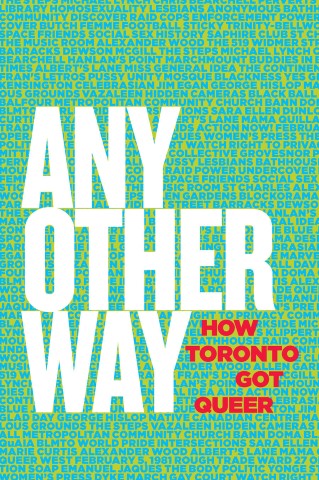Intentionally pushing the boundaries, this LGBTTIQQ2SA history aims for inclusivity, representation and originality.
These essays are designed to “dazzle” and to “distract” readers from the convention (in this city and beyond) of the queer narrative’s domination by the white/male/cis/middle-class/able-bodied perspective.
There are more than 100 short pieces to expand that story. Some are a couple of paragraphs long, most two or three pages, some as long as seven pages.
Most of the pieces are illustrated, some abundantly so. There ae plenty of photographs, of course, but also some artwork. In addition, there are diagrams and newspaper headlines, maps and excerpts from pamphlets, song lyrics, poems and pictures of buttons.
The variety of docments adds to the sense that this is a multidimensional story, as does the variety of contributors (very few author more than one piece).
More than any other factor, however, what creates the sense of inclusivity is the variety of styles and voices.
The emphasis is consistently on accessibility – not one piece reads like an academic treatise – but, even so, some pieces report and others expose.
Even those pieces which are more formal still feel personal. For instance, Mathew Gagné’s piece, which contains some big ideas and some personal reflections.
“To look at Toronto’s queer geography in the digital age entails considering the physical and the virtual, the public and the private, and the personal and the collective as shifting dichotomies that overlap. There are multiple kinds of spaces, some trodden by many, others only by a few. Each day I move within Toronto, the urban landscape becomes a living palette that ignites my queer life and gives it shape, meaning, memory, and attachment.”
Many of the pieces feel decidely intimate, not just personal.
“Dress-up for me as a kid was not cowboys and Indians. It was finding just the right cigarette holder and just the right wig, and bottles and bottles of half-used Aqua Net and nylons, and figuring out whether that ratty feather boa was still going to work. And just exactly how could I get away with a Bette Davis voice at seven years old.”
There are some footnotes, yes, but there are also some diary entries. Readers who have a strong preference can just turn a couple of pages and find another kind of style, another kind of voice.
In “Arriving” and “Spaces”, readers explore contemporary spaces (from Barbara Hall Park to The 519) and historical spaces (Albert Lane, now buried beneath The Eaton Centre, and The Steps, now buried under concrete), long-time residents (who grew up here) and recent arrivals (like a gay couple who arrived from Syria in June 2016).
In “Demimonde”, readers move from hotel bars to drag balls and cabarets, and in “Emergence”, there are spy holes and coffee houses, gay bars and gay journalists.
In “Resisting, Sharing, Organizing”, the longest section in the book, readers visit bookshops and theatres, sex-clubs and queer churches.
In “Epidemic”, there’s talk of care-giving schedules and medical trials. In “Scenes”, readers consider installations and multi-media events.
In “Sex”, scenes include park cruising and locker rooms. In “Rites and Rules”, readers visit the Metropolitcan Community Church and Casa Loma.
“Pride” includes discussion of the first Pride week in Toronto in July 1972 and June 2016’s parade including the Black Lives Matter protest.
Any Other Way focuses on “hyperdiversity” and “immense intersectionality” as it seeks to expand the narrative.
If your TBR stack could use some glitter, consider the dazzling power of sequins.
Toronto Book Award 2017
One of five books nominated by this year's juryAny Other Way: How Toronto Got Queer
“This is an extraordinary book, and one of the most important collections of writing by Torontonians ever published.”
Read the rest of the jury’s comments and check out the editorial list by clicking on the image above.


[…] This Will Matter Sonny Liew’s The Art of Charlie Chan Hock Chye John Lorinc, Ed (and others) How Toronto Got Queer Kyo Maclear’s Birds Art Life Javiar Marias’ Written Lives Paule Marshall’s […]
This sounds excellent. But when I looked at the whole list, they all did! Are you going to let us know your prediction/preferences?
The thing about the Toronto Book Award is that it’s open to fiction and non-fiction which, to my reader’s mind, makes comparison a real challenge. And my own natural preference is fiction, although I am really working to read more non-fiction, and this year there is only one novel on the list: Catherine Hernandez’s Scarborough!
Oh, that is hard.